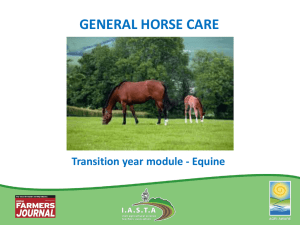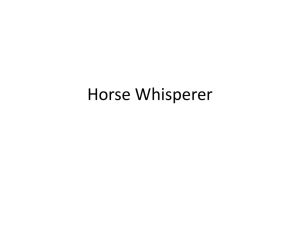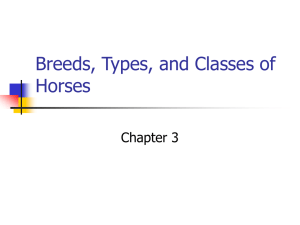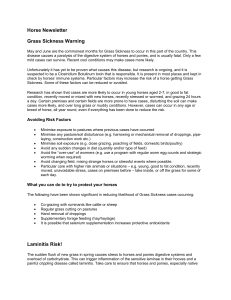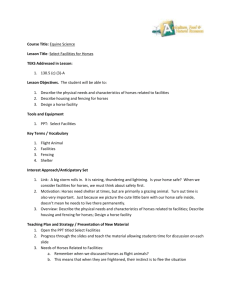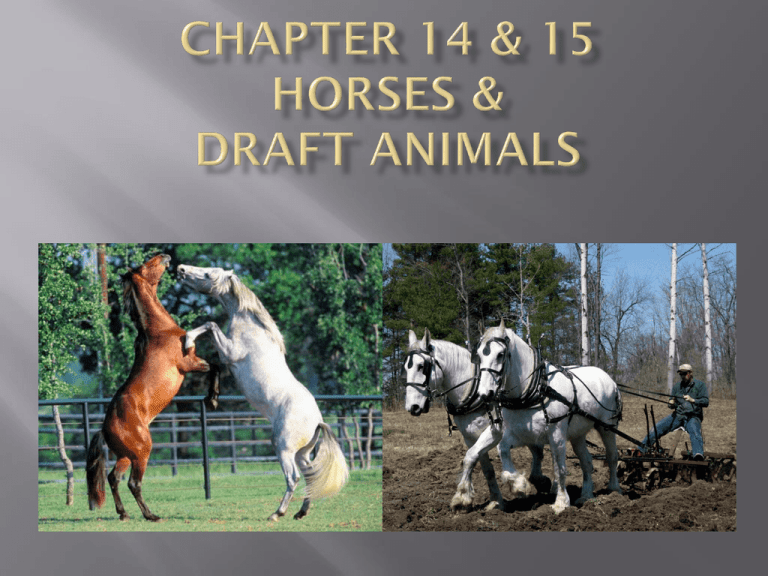
Racing horses is the largest
spectator sport in the world
In the 1800s and early 1900s
horses were used for power
and transportation
The United States had 20
million horse in the 1900s
In 1977 – 9 million horses
In the late 1980s fewer than
6 million
In 2004 horse numbers have
increased to 6.6 million
Uses – work,
companions, and
hobbies, as well as
animal-pull events.
Animals used for draft, horses, oxen,
donkeys, mules,
camels, and buffalo.
Oxen
Mules
Draft
Shire
Clydesdale
Percheron
Belgian
Suffolk
Riding horses
Gaited horses
Stock horses
Polo Mounts
Hunter and
Jumpers
Ponies
Racehorses
Driving Horses
Scientific name –
Equus caballus
Mare – mature female horse 4
+ years
Stallion – mature male horse 4
+ years
Foaling – giving birth in horses
Foal – young horse either sex;
not weaned
Stud horse – male horse used
of breeding
Filly – young female horse
under 3 years
Colt – young male horse under
3 years
Gelding – castrated male horse
Hands – equal to 4
inches
Classified by size
Light Horses –
14.2 – 17 hands
(900 – 1400
pounds)
Draft – 14.2 – 17.2
hands (1400 +
pounds)
Ponies – 14.2 and
under (500 -900
pounds)
Use
Price range
Disposition
Size
Gait
Breed
Color
Normal Breeding
Artificial
Insemination
Parturition – best sign
of parturition udder is
distended
Care after parturition
– imprinting
Oxen – Duration of their
cycle – 12-20 hours every
21 days. Gestation – 9
months 270-295 days
Draft Horses – puberty at
12-15 months, estrous
cycle is every 21 days,
heat is 4-6 days in length;
gestation is 11 months or
330-340 days.
Draft Capacity – can pull
1/10 of its body weight
Draft Animal Selection –
Social ranking in herd
Concentrates – Grains (oats,
corn, and barley)
Monogastric
One pound of grain for every
1000 pounds of horse per day
Colic – common problem if
over feeding concentrates
Forages – pasture or hay. 1-2
pounds for each 100 pounds
of body weight each day.
One horse per 3 acres on
which to graze.
Supplement minerals and
vitamins
Water – clean and plenty of it
(10-12 gallons per day)
Feeding Oxen
- ruminants
Feeding Draft
Horses Monogastric
Feeding
Schedules –
hand-feeding,
self-feeding,
automated
feeding
Colic
Sleeping Sickness
Swamp Fever
Equine influenza
Founder
Tetanus (lock Jaw)
External Parasites
Internal Parasites
Condition animal - Groom
Consider health
General health – temp 100.5 F
Horses; 101.5 F Oxen
Parasites – internal and
external
Foot Care – trim every 6
months
Farrier
Clean Frog
Determine age by
teeth – slanted teeth
- older
Floating the teeth –
smooth out sharp
edges on the teeth.
Barn
Feeding equipment
Grooming
Saddle and bridle
(Western or English)
Strong fences and stalls
Equipment – harness
or yoke
Mounting and
Dismounting – left side
Seat Position – sit tall;
erect
Horse Control
Hands
Legs
Voice
Weight
Movement
Walk
Gallop
Backing
Stopping
Jog
Lope




